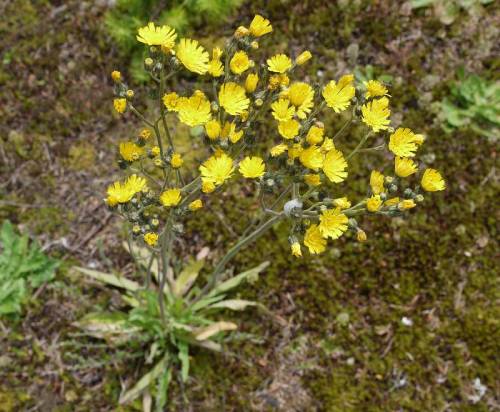Tall hawkweed identification and control
Information about the noxious weed, tall hawkweed. Tall hawkweed is also known by its Latin name, Hieracium piloselloides.
About this weed
Tall hawkweed is a regulated Class B noxious weed in King County. This means control is required in King County under the state noxious weed law. Tall hawkweed is also on the Washington quarantine list meaning it is illegal to buy or sell in the state.
Tall hawkweed is known as Hieracium piloselloides and it is in the aster/daisy/sunflower family.

Why it’s a problem
Hawkweeds often invade sites in cleared forest zones which are low in available nutrients. Hawkweeds are thought to persist in these sites because they capture nitrogen in nutrient-poor soils, limiting nutrients available to competing plants. When hawkweeds form monocultures by establishing a dense mat of plants, they lower biodiversity and reduce the forage value of grasslands for grazing animals.
Plant description
General characteristics of hawkweeds
Hawkweeds were introduced to the United States from Europe as herbal remedies and ornamentals. Hawkweeds are all perennials (plants that have a life cycle of 2 or more years). They belong to the sunflower family and have a milky juice, yellow or orange dandelion‐like flower heads and bristly hairs overall.
Plants have rosettes (a circular cluster of leaves on ground level). Basal leaves of most non‐native hawkweeds usually persist through flowering. Many non‐native hawkweeds have stolons (horizontal plant stems that root and form new plants), but not all, and there are no native Washington hawkweed species with stolons.
Characteristics of tall hawkweed
Tall hawkweed is mostly found in low-nutrient, coarse soils, particularly along roadsides and in outwash areas. It has been documented in King, Snohomish, Cowlitz and Grays Harbor counties.
Tall hawkweed can grow up to 3 feet tall with a mostly leafless stem. Its stems and leaves have long hairs along the leaf margins (edges) and lower midrib. Leaves are not obviously toothed and are narrow.
Yellow flower heads open from hairy black clusters of buds at the tip of the stem.
Tall hawkweed has a shallow root system and underground creeping rhizomes (root system that spreads outwards and can grow new stems). Tall hawkweed does not form stolons like some of the other yellow-flowered non-native hawkweeds.
Tall hawkweed spreads by seeds, root buds and rhizomes. It usually flowers in June or July and sets seed by August.







Be aware of look-alike plants
There are many non-native and native hawkweed species in the pacific northwest, making individual hawkweed species very difficult to identify. Many people think tall hawkweed and dandelions look alike.
When in doubt, take photos and share them with us or report them on iNaturalist.
What to do if you find it
Property owners are required to control tall hawkweed on lands that they manage. Please notify us if you see tall hawkweed growing in King County. Our program staff can provide you with site-specific advice on how best to remove it. We map all known locations of regulated noxious weeds in order to help locate new infestations in time to control them.
Control methods
We recommend using a combination of methods to control noxious weeds. In areas with few weeds, it is important to act quickly before they become harder to control. Make a long-term plan as it often takes several years to get rid of most weeds. Start in the least infested areas first and then move into more heavily infested areas.
For more in-depth control information, read Best Management Practices (BMP) for hawkweeds
Mechanical control
Small populations can be removed by digging. Make sure to remove the entire root since plants can resprout from root crowns. If plants are in flower, bag and discard flowering stems to avoid spreading seeds.
Large areas infested with hawkweed are highly difficult to manage.
Mowing is not a recommended type of control for hawkweeds. Do not attempt to control by mowing unless mowers can be cleaned before moving to new areas and all the flowering stems can be collected and discarded. Plants will regrow after being mowed and flower again in the same season.
Chemical control
Stay safe when using herbicide:
- Always read the label before use.
- Wear a long-sleeved shirt, long pants, shoes, and eye protection.
- Follow state and local regulations.
Herbicide may be useful for large infestations. If the site is wet or along the water's edge, it may require a permit issued by the Washington Department of Ecology. Use of a selective broadleaf herbicide such as triclopyr will be best to control non-native hawkweeds. Monitor the area for new plants that germinate from the seedbank for several years following initial treatment.
Apply to plants in spring or early summer when plants are actively growing and before they fully flower. Flowering plants can go to seed immediately when sprayed. Take care to avoid desirable plants.
Contact your local noxious weed program or county extension office for recommendations on herbicides.
See the PNW Pest Management Handbook for the most up to date and specific methods for chemical control of tall hawkweed.
Disposal instructions
Bag all flower heads. If the plants are in seed, carefully cut off the seed head and place in a bag without dispersing the seeds. Dispose of flower heads and plants in household garbage or take to a transfer station for disposal. Do not compost or put in yard waste. Never dump plant material in parks or natural areas because weeds can spread from yard waste piles.
Noxious Weed Disposal - Washington State Noxious Weed Control Board

 Translate
Translate